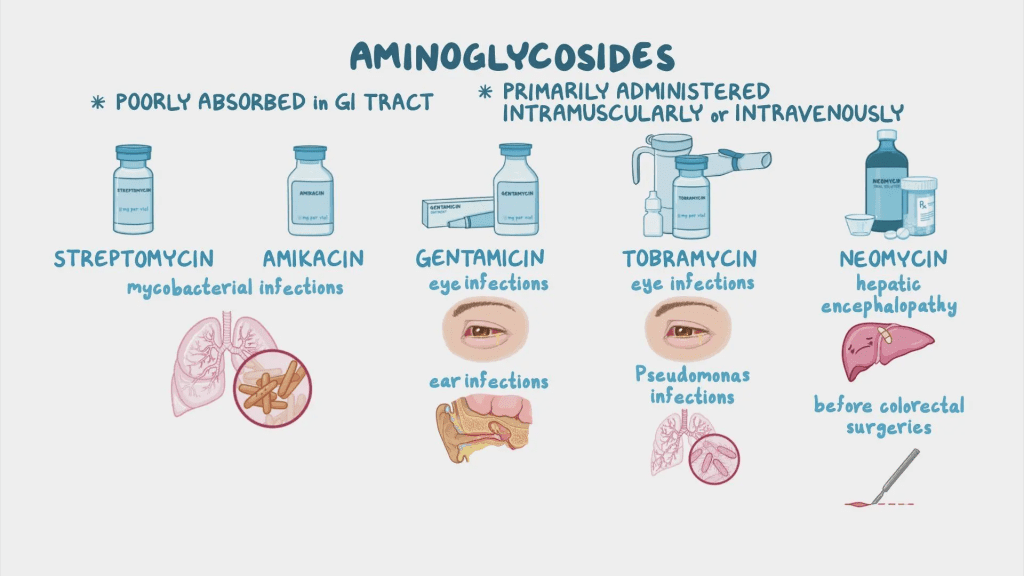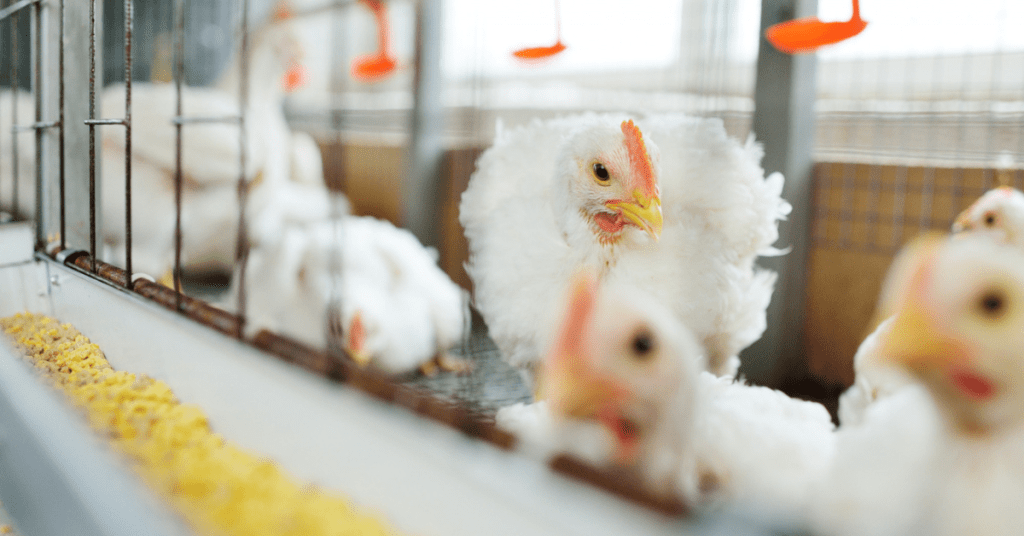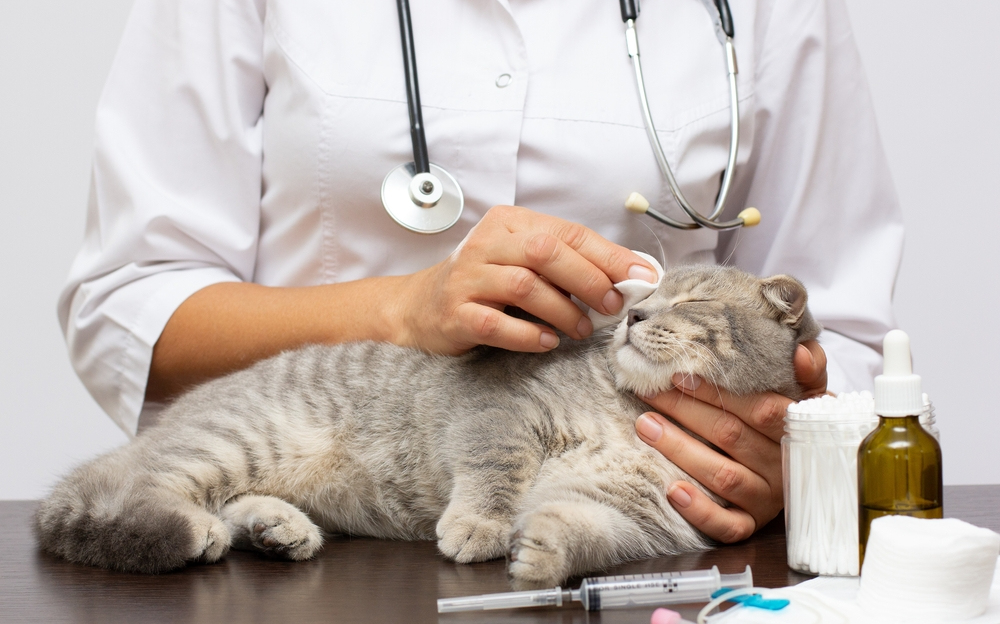Aminoglycosides are a vital group of bactericidal antibiotics widely used in veterinary pharmacology and human medicine. Characterized by polybasic amino groups linked glycosidically to amino sugars, these drugs are especially effective against Gram-negative bacteria. First discovered in 1944 with the isolation of streptomycin from Streptomyces griseus, this class now includes well-known antibiotics such as gentamicin, neomycin, kanamycin, amikacin, and tobramycin.
Aminoglycosides are produced primarily by soil-dwelling actinomycetes. Those derived from Streptomyces carry the suffix “-mycin,” while those from Micromonospora end with “-micin.” These antibiotics are water-soluble, highly polar, poorly absorbed orally, and are excreted largely unchanged via urine. They demonstrate a concentration-dependent bactericidal effect and exhibit post-antibiotic effect, making them especially effective when used in a single high dose.
Mechanism of Action of Aminoglycosides in pharmacology

The bactericidal action of aminoglycosides involves two main processes:
- Entry into Bacterial Cells: They enter Gram-negative bacteria through porin channels and cross the periplasm via an oxygen-dependent mechanism.
- Binding to Ribosomes: Aminoglycosides bind irreversibly to the 30S subunit of bacterial ribosomes, inhibiting protein synthesis by causing misreading of mRNA and ultimately leading to cell death.
Antibacterial Spectrum
The antimicrobial spectrum varies depending on the drug:
- Narrow-spectrum: Streptomycin, active mainly against aerobic Gram-negative bacilli.
- Broad-spectrum: Neomycin and kanamycin, effective against both Gram-negative and Gram-positive bacteria.
- Extended-spectrum: Gentamicin and amikacin, which are also effective against Pseudomonas species.
Resistance Mechanisms
Bacterial resistance to aminoglycosides can occur via:
- Enzymatic inactivation through plasmid-mediated enzymes (e.g., acetyltransferases).
- Impaired transport across cell membranes.
- Mutation in ribosomal binding sites reducing drug affinity.
Pharmacokinetics Overview

- Poor oral absorption; IM administration leads to high bioavailability.
- Distributed in extracellular fluids; minimal intracellular penetration.
- Accumulates in renal tubular cells and the inner ear—key to its nephrotoxic and ototoxic effects.
- Excreted unchanged in urine; half-life is 2–4 hours (up to 48 hours in renal dysfunction).
Adverse Effects and Contraindications
- Nephrotoxicity: Accumulates in proximal tubules leading to proteinuria, decreased GFR.
- Ototoxicity: Damage to cochlear or vestibular apparatus causing hearing loss, ataxia.
- Neuromuscular Blockade: Risk of apnea and respiratory arrest.
- Contraindicated in renal disease, pregnancy, neonates, geriatrics, and myasthenia gravis patients.
Important Drug Interactions
- Potentiated toxicity with loop diuretics and halothane.
- Synergistic with β-lactam antibiotics.
- Risk of enhanced neuromuscular blockade when combined with anesthetics.
Common Aminoglycosides in Veterinary Pharmacology Practice
1. Streptomycin (Narrow Spectrum)
- Mechanism: Binds to 30S ribosome → Codon misreading → Inhibits protein synthesis.
- Uses: Shipping fever, foot rot, mastitis (with penicillin), coliform infections.
- Dose: 5–10 mg/kg IM (dogs), 10 mg/kg (large animals), 100–500 mg/quarter (mastitis).
2. Neomycin (Broad Spectrum)
- Source: Streptomyces fradiae.
- Use: GI infections, skin/ear/eye infections, pre-surgical bowel sterilization.
- Toxicity: Highly nephrotoxic and ototoxic.
- Dose: Dogs: 10 mg/kg PO; Cattle: 10–20 mg/kg PO.
3. Gentamicin (Extended Spectrum)
- Source: Micromonospora purpurea.
- Spectrum: Active against Staphylococcus, Pseudomonas, E. coli, Klebsiella, etc.
- Use: Respiratory, urinary, skin infections; mastitis, metritis.
- Dose: Dogs: 5 mg/kg IM or SC daily; Cattle: 2.5–5 mg/kg IM, 2–3 times daily.
Final thoughts on veterinary pharmacology
Want to master veterinary pharmacology and antibiotic mechanisms for your thesis, entrance exams, or PSC prep?
Join our full Veterinary Pharmacology Series at Pedigogy.com — designed for agri and vet students in Nepal. You can also Enroll in the full course of Pharmacology here:https://pedigogy.com/courses/veterinary-pharmacology/


